
 |
Tea Clipper |
 |
| from TeaAntiques.com | ||
| Edition Forty Six |
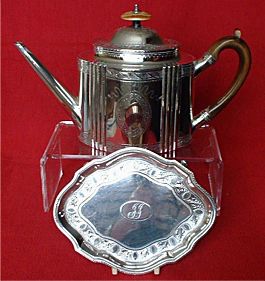 A stunning bright-cut teapot and stand by the reputable
eighteenth century London silversmith, Robert Hennell. The Hennell family
established as a silver making dynasty with Robert's father, David Hennell, who first
registering his mark in 1736. David Hennell was joined by his son Robert in 1763
and worked with him until 1797. Robert registered his own maker's mark in 1772
and 1773 and became a pioneer in producing the neo-classical style in silver,
following the design fashions set by the architect, Robert Adam. This teapot and
stand show this neo-classicism to perfection with its delicate motifs of
bright-cut decoration.
A stunning bright-cut teapot and stand by the reputable
eighteenth century London silversmith, Robert Hennell. The Hennell family
established as a silver making dynasty with Robert's father, David Hennell, who first
registering his mark in 1736. David Hennell was joined by his son Robert in 1763
and worked with him until 1797. Robert registered his own maker's mark in 1772
and 1773 and became a pioneer in producing the neo-classical style in silver,
following the design fashions set by the architect, Robert Adam. This teapot and
stand show this neo-classicism to perfection with its delicate motifs of
bright-cut decoration.
By 1795, Robert Hennell had registered a mark with his own son, David - and so the family silversmith skills continued. Robert was a maker of the very finest quality small domestic wares including baskets, salt cellars, epergnes and teapots.
More details of this item and other tea related antiques can be found by visiting my web site at www.TeaAntiques.com.
As promised in the last edition, after my tour through this Victorian weekend house party, which I thoroughly enjoyed, I have returned to the beautiful town of Warwick to view the State Apartments of Warwick Castle.
The State Apartments are reached by going back into the Castle Courtyard from the 'Royal Weekend Party' tour and then re-entering the Apartments by another door. First to the left as you enter is the Private Chapel of the Castle. It is here that the Earls of Warwick would have carried out their worship. It was also used by the servants within the Castle for their own worship.
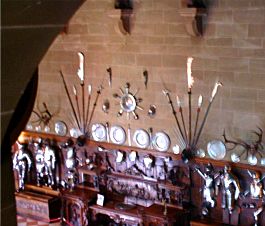 Leading
on, there is the open and impressive central Great Hall, the walls as one might
expect in a Castle, hung with shining armour. Much of this armour is Italian and
dates from the sixteenth century. Even the horses of the Knights had their own
armour for protection. In earlier times, the Great Hall would have been the
communal living and sleeping area for the Castle's nobility, an open log fire
would have burnt on the floor in the centre of the Hall with smoke escaping
through a hole in the great ceiling above.
Leading
on, there is the open and impressive central Great Hall, the walls as one might
expect in a Castle, hung with shining armour. Much of this armour is Italian and
dates from the sixteenth century. Even the horses of the Knights had their own
armour for protection. In earlier times, the Great Hall would have been the
communal living and sleeping area for the Castle's nobility, an open log fire
would have burnt on the floor in the centre of the Hall with smoke escaping
through a hole in the great ceiling above.
To one side of this Great Hall is the State Dining Room. Unlike the rooms previously seen from the Victorian era, this room was commissioned in 1763, by Francis Greville. It has geometric white and gold panelled walls with some heavy gilt furniture, including a heavy looking baroque-style side table with caryatid figures supporting the top, these covered in gold leaf and dates from c1690-1710.
At the far end of the room hangs a magnificent portrait of King Charles I on horseback. The white marble fireplace is the work of Robert Adam, bringing a touch of neo-classical decoration to the room.
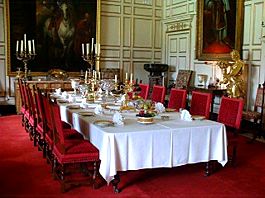
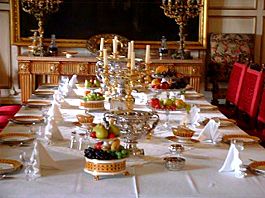
The large rectangular oak table is covered with a white table cloth and is set with the Castle's finest table wares for a dinner party. There are some fine gilt candelabra, fine china from a dessert service from Paris c1825 and glass, including a glass pyramid of fresh fruits for the dessert.
Other State Rooms in precession include the Red Drawing Room, Cedar Drawing Room, Green Drawing Room, Queen Anne Bedroom and Blue Boudoir. Each room with its own style and furnishings.
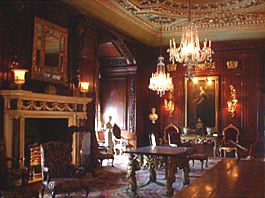 The
Cedar Drawing Room takes its name from the dark Cedar wood panelling which
dates from the 1670's. This panelling makes the room somewhat gloomy, but the
five large and sparkling crystal glass chandeliers help to elevate the gloom.
These chandeliers hang from an ornate plaster ceiling, rather in Italian style,
painted green with gilded embellishments.
The
Cedar Drawing Room takes its name from the dark Cedar wood panelling which
dates from the 1670's. This panelling makes the room somewhat gloomy, but the
five large and sparkling crystal glass chandeliers help to elevate the gloom.
These chandeliers hang from an ornate plaster ceiling, rather in Italian style,
painted green with gilded embellishments.
In this room are some very fine English carved seat furniture, including some high quality Chippendale-type open arm chairs, each covered with remarkable tapestries. These sit upon a vast Aubusson carpet, woven for the Earl of Warwick in the nineteenth century. In the corners of this delightful carpet is woven the emblem of the Earls of Warwick, a 'Bear and Ragged Staff'.
Other fine Chippendale pieces within this grand room are two side tables against the walls and interestingly, four carved wall lights, each gilded.
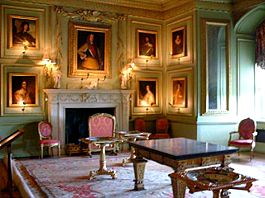 The
next room in this precession of State Rooms is the Green Drawing Room. Unlike
the Cedar Room, this appears altogether much lighter and brighter. In here, the
walls are not of dark wood panelling, but painted in a restful green with gilt
plasterwork. A large and handsome white carved marble fireplace graces the end
of the room, the central panel carved with a proud Lion.
The
next room in this precession of State Rooms is the Green Drawing Room. Unlike
the Cedar Room, this appears altogether much lighter and brighter. In here, the
walls are not of dark wood panelling, but painted in a restful green with gilt
plasterwork. A large and handsome white carved marble fireplace graces the end
of the room, the central panel carved with a proud Lion.
The main item of furniture in this room has to be the central rectangular table from Florence, Italy. Dating from the sixteenth century, its top is inlaid with semi-precious stones. It stands upon a sturdy gilded frame-needed to support such a heavy top.
Many of the portraits around this room are from the time of the Civil War in England, including King Charles I who lost his head as a result of this war. On a lighter note, the room contains some very fine gilt framed French style saloon furniture, covered in a deep pink silk upholstery.
Passing through the Queen Anne Bedroom, I reached the room that maybe I liked the most, the Blue Boudoir. This was certainly in my mind the most attractive looking room in the State Apartments, nice and light and in the 'French' Style for the ladies, decorated in the 1870's.
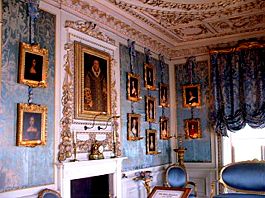
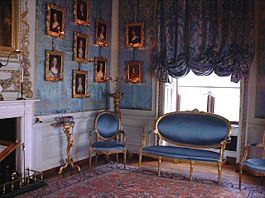
Above the fireplace in the Blue Boudoir is a portrait of King Henry VIII from the studio of Hans Holbein. Around the walls are smaller contemporary portraits from the time of Henry VIII, including the Boleyn sisters, Anne and Mary. The walls of this charming room are hung with beautiful pastel blue and silver silk from France. The furniture too is covered in blue upholstery and has French gilt wood frames.
The wood carving above the fire place is the very fine workmanship of the Warwick estate carpenter and frames the portrait of Henry VIII most handsomely.
On the wall opposite to the fireplace is a curious silver faced wall clock. This is maybe appropriately housed in this French style room, as it is believed to have belonged to Marie Antoinette, wife of the French King Louis XVI, both beheaded in the revolution in 1793.
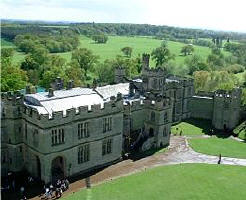
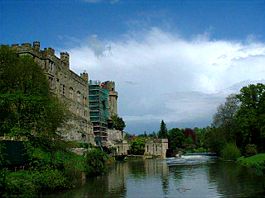
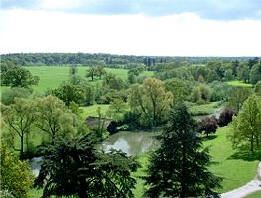
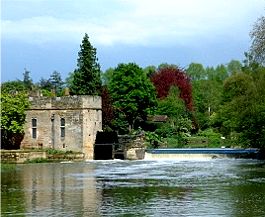 Having
completed the fine rooms within the Castle, I took a turn round the delightful
grounds surrounding it. The gardens are bounded on one side by the river Avon. From down
by the river there are some good views of the Castle's high construction and at
the far end, the mill. This mill with its working water wheel provided power to
the Castle as well as used for catching Eels from the river! It is possible to
tour the mill, where inside are the original power generators that provided the
Castle's electricity for lighting in the nineteenth century - what a breakthrough
that was for the castle, which until then would have been very dark
and gloomy at night.
Having
completed the fine rooms within the Castle, I took a turn round the delightful
grounds surrounding it. The gardens are bounded on one side by the river Avon. From down
by the river there are some good views of the Castle's high construction and at
the far end, the mill. This mill with its working water wheel provided power to
the Castle as well as used for catching Eels from the river! It is possible to
tour the mill, where inside are the original power generators that provided the
Castle's electricity for lighting in the nineteenth century - what a breakthrough
that was for the castle, which until then would have been very dark
and gloomy at night.
A very pleasant part of the garden is known as the 'Peacock Garden'. This formal garden is set to afford pleasant views down towards the river in the distance and is set around a circular pond and fountain. The formal beds are enhanced with trained and clipped Yew hedges, many shaped to look like Peacocks. Also, there are many real live peacocks 'strutting' around the gardens too. A very attractive garden, backed by the old conservatory.
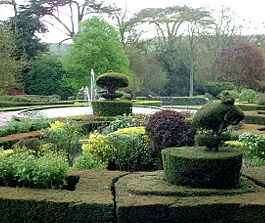
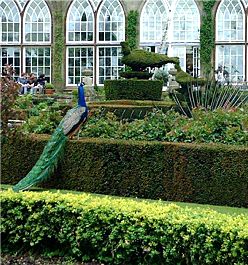
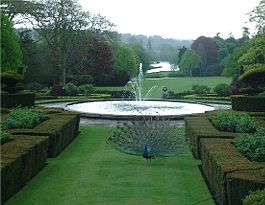
I can certainly recommend a day spent in the town of Warwick and a visit to the castle which provides a wonderful insight into the life and history of this impressive home and fortress.
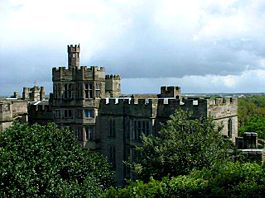
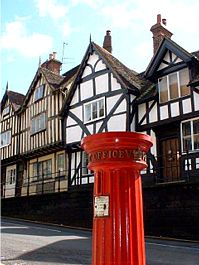
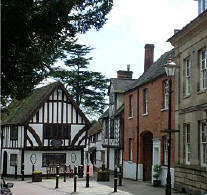
As well as the attraction of the magnificent Castle, the town with its many historic and attractive buildings, also has a lot to offer the visitor. I hope that my article this month, as well as the previous visit to Warwick last month, has given you some idea of what delights are there for the visitor.
Warwick CastleClick here for
Local Map
Map courtesy of www.streetmap.co.uk
To review past newsletters, just follow this link:
Past newsletters.
To subscribe to this free newsletter -
Click here